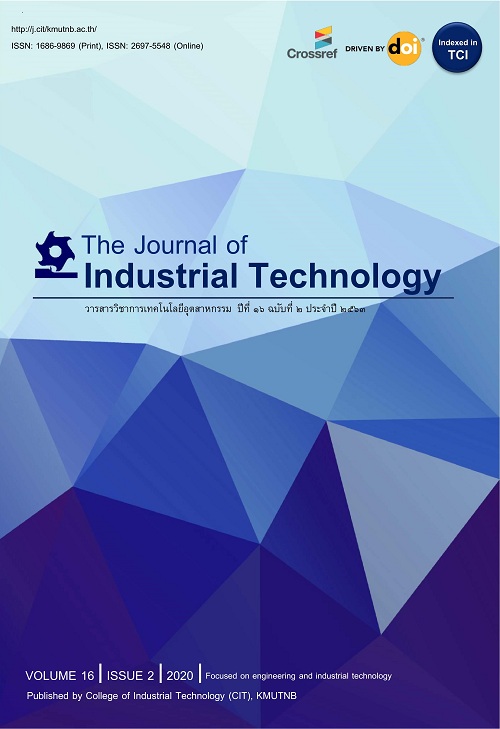การเปรียบเทียบประสิทธิภาพของเชื้อเพลิงอัดแท่งจากวัสดุเหลือใช้ทางการเกษตร
The Efficiency Comparison of Fuel Briquettes from Agricultural Wastes
Abstract
การวิจัยครั้งนี้มีวัตถุประสงค์เพื่อศึกษาความเป็นไปได้ของเชื้อเพลิงอัดแท่งจากวัสดุเหลือใช้ทางการเกษตรหลายชนิด ทำการศึกษาอัตราส่วนที่เหมาะสมของวัสดุเหลือใช้ทางการเกษตรกับตัวประสาน และเปรียบเทียบคุณสมบัติทางเคมีและกายภาพของเชื้อเพลิงอัดแท่งจากวัสดุเหลือใช้ทางการเกษตร ดำเนินการทดลองโดยวัสดุเหลือใช้ทางการเกษตร ได้แก่ กากอ้อย (BG) ขี้เลื่อยยางพารา (WS) ซังข้าวโพด (CC) ฟางข้าว (RS) ใบไม้ยางพารา (LP) และเศษไม้ยางพารา (RC) ผสมกับตะกอนแป้งมันสำปะหลังแห้ง (CS) เสมือนเป็นตัวประสาน ที่อัตราส่วนของ 0.25:0.75, 0.50:0.50 และ 0.75:0.25 กิโลกรัมต่อกิโลกรัม ตามลำดับ และขึ้นรูปเชื้อเพลิงอัดแท่งด้วยกระบวนการอัดเย็น จากนั้นศึกษาคุณสมบัติทางเคมีของเชื้อเพลิงอัดแท่งคือ ค่าความร้อน ปริมาณความชื้น และปริมาณเถ้า และคุณสมบัติทางกายภาพคือ ความหนาแน่นและดัชนีแตกร้าว รวมทั้งประสิทธิภาพการใช้งานของเชื้อเพลิงอัดแท่งจากวัสดุเหลือใช้ทางการเกษตร ผลการศึกษาพบว่า เชื้อเพลิงอัดแท่งของเศษไม้ยางพาราผสมกับตะกอนแป้งมันสำปะหลังที่อัตราส่วน 0.50:0.50 เป็นเชื้อเพลิงทางเลือกที่มีประสิทธิภาพสูงสุด (ค่าความร้อน 4,136.9728 แคลอรี่ต่อกรัม ปริมาณความชื้นและปริมาณเถ้า 7.33 และ 5.33 ร้อยละโดยน้ำหนัก ตามลำดับ ความหนาแน่น 0.47 กรัม/ลูกบาศก์เซนติเมตร และดัชนีแตกร้าว 0.78) และสามารถประยุกต์เป็นแนวทางของการผลิตเชื้อเพลิงอัดแท่งจากวัสดุเหลือใช้ทางการเกษตรสำหรับใช้เป็นแหล่งพลังงานทางเลือกของชุมชน
The objectives of this research were to study the feasibility of fuel briquettes from various types of agricultural wastes, to study the optimal ratios of agricultural wastes and binder and to compare the efficiency of chemical and physical properties on fuel briquettes from agricultural wastes. The experiment was conducted by the agricultural wastes such as bagasse (BG), rubber wood sawdust (WS), corn cobs (CC), rice straw (RS), leaves of para rubber (LP) and rubber wood chips (RC) that were mixed with dry cassava starch sediment (CS) as a binder at the ratios of 0.25:0.75, 0.50:0.50 and 0.75:0.25 kg:kg, respectively. Also, the fuel briquettes were formed by a cold pressed process. Then, study of chemical properties of fuel briquettes were heating value, moisture content, and ash content and their physical properties were density and drop shatter test including performance of fuel briquettes from agricultural wastes. Results showed that the fuel briquette from rubber wood chips mixed with cassava starch sediment was at 0.50:0.50 was the most effective alternative fuel (heating value was 4,136.9728 cal/g, moisture content and ash content was 7.33 and 5.33 % w/w respectively, density of 0.47 g/cm3 and drop shatter of 0.78) and it can be applied as a guideline of fuel briquettes from agricultural wastes for using alternative energy source in community.
Keywords
เชื้อเพลิงอัดแท่ง; วัสดุเหลือใช้ทางการเกษตร; ตะกอนแป้งมันสำปะหลัง
Fuel briquette; Agricultural waste; Cassava starch sediment
[1] T. Tantisattayakul, S. Phongkasem, P. Phooyar and P. Taibangury, Community-Based Renewable Energy from Biomass Briquettes Fuel from Coconut Leaf, Thai Journal of Science and Technology, 2015, 23(3), 418-431. (in Thai)
[2] http://webkc.dede.go.th/testmax/sites/ default/ files/energy%20biomass.pdf. (Accessed on 15 June 2020)
[3] http://elib.dede.go.th/mm-data /Bib15106_ finalreport.pdf. (Accessed on 15 June 2020)
[4] N. Photong and J. Wongthanate, Biofuel Production from Bio-Waste by Biological and Physical Conversion Processes, Waste Management and Research, 2020, 38(1), 69-77.
[5] ASTM Standard D5865, Standard Test Method for Gross Calorific Value of Coal and Coke, ASTM International, West Conshohoc ken, PA, 2013.
[6] ASTM Standard D3173, Standard Test Method for Moisture in the Analysis Sample of Coal and Coke, ASTM International, West Conshohocken, PA, 2013.
[7] ASTM Standard D3174, Standard Test Method for Ash in the Analysis Sample of Coal and Coke, ASTM International, West Conshohocken, PA, 2013.
[8] N. Tanpaiboonkul and T. Budnumpetch, Molding and Binding Method on Properties of Fuel from Water Hyacinth, Veridian E-Journal, Science and Technology Silpakorn University, 2016, 3 (6), 86-100. (in Thai)
[9] R. Garcia, C. Pizarro, A. Gutiérrez Lavín and L. Julio Bueno, Characterization of Spanish biomass wastes for energy use, Bioresource Technology, 2012, 103, 249 - 258.
[10] L. Wattanachira, A. Thanyacharoen, N. Laa pan, and V. Chatchavarn, Development of Biobriquettes from Mixed Rice-straw and Longan Waste Residues, Journal of Research and Development Rajamangala University of Technology Lanna, 2016, 39(2), 239-255. (in Thai)
[11] A. Ussawarujikulchai, C. Semsayun, N. Prapakdee, N. Pieamsuwansiri and N. Chuchat, Utilization of Durian and mango- steen Peels as Briquette Fuel, 49th Kasetsart University Annual Conference, Proceeding, 2011, 162-168. (in Thai)
[12] Thai Industrial Standards Institute (TISI), Ministry of Industry. Thai Community Product Standards Charcoal Bar TCPS number 238/2547, 2004. (in Thai)
[13] Thai Industrial Standards Institute (TISI), Ministry of Industry, Ministry of Industry, Thai Community Product Standards Wood Charcoal for Cooking TCPs 657/2547, 2004.
[14] S. Sunthararuk, D. Makmon and W. Wongmalee, The Development of Charcoal Fuel Briquettes from Eucalyptus Leaves and Brasiliensis Leaves, 2nd National and International Research Conference 2018, Proceeding, 2018, 339-348. (in Thai)
[15] K. Saha, M. Hossain, R. Ali, and M. Alam, Feasibility Study of Coconut Coir Dust Briquette, Journal of the Bangladesh Agricultural University, 2014, 12(2), 369-376.
DOI: 10.14416/j.ind.tech.2020.12.003
Refbacks
- There are currently no refbacks.






